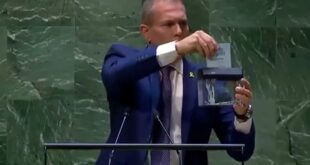America and China Need to Cooperate on Relief
In April 2020, with the global economy going into free fall, the risk of developing countries defaulting on their debts grew acute. The leaders of the G-20—a group of the world’s largest economies—quickly put in place an initiative that would suspend debt service payments for the government-to-government loans of 73 poor countries. The support afforded poor countries breathing room during the pandemic. That initiative ended in December 2021, succeeded by a program called the Common Framework, which brings G-20 governments together with the 22 members of the Paris Club, an informal group of mostly wealthy creditor countries established in 1956 to act collectively on debt relief requests. The Common Framework could bring private creditors together with G-20 and Paris Club governments to jointly help manage the debts of the same 73 poor countries. Yet this bold and long-overdue process is teetering on the brink of collapse.
If the Common Framework fails, toxic geopolitics will be to blame. China and the United States have found themselves at odds over the conception and operation of sovereign debt relief. U.S. officials regularly single out China as an unforgiving creditor, the source of “debt traps,” and an obstacle to lasting solutions. “China has been the spoiler,” the U.S. ambassador to Sri Lanka said recently, in reference to that island country’s debt struggles. But research I have conducted with my colleague Yufan Huang shows that China actually played a responsible role in the G-20’s earlier initiative, providing 63 percent of the total $13.1 billion in suspensions despite holding only 30 percent of all debt service claims. Other researchers note that even when China is not involved, delays in the restructuring of sovereign debts are unfortunately common, lasting on average eight years. To keep China on board, other G-20 countries need to support a more equitable sharing of financial burdens among private, public, and perhaps multilateral creditors, and the United States needs to rethink its shortsighted strategy of scapegoating China as an uncooperative actor. In return, Beijing needs to accept that debt write-downs are inevitable and convince skeptics within the Chinese government and the Chinese Communist Party to stay engaged in the process. Nearly 60 percent of low-income countries are now at high risk of, or are already in, debt distress. To weather the coming storm, they need the world’s preeminent financial powers—China and the United States—to cooperate.
DON’T MAKE THEM PAY
The last systemic debt crisis was sparked when then Federal Reserve Chair Paul Volker hiked U.S. interest rates over 20 percent between 1979 and 1982. Because loans were generally priced in dollars with variable interest rates, debt servicing costs in poor countries shot up, leaving little for social spending. “Must we starve our children to pay our debts?” former Tanzania President Julius Nyerere asked in 1986. For the next 25 years, poor countries were ravaged; the Paris Club processed over 300 debt relief requests. Volker would later accept that he had not considered the damage that such a decision would cause in poorer countries, admitting, for instance, that “Africa was not even on my radar screen.” In the early years of this century, the International Monetary Fund (IMF) launched an effort to work out new rules, proposing a mechanism that would have, in effect, created a bankruptcy court for sovereign countries. The United States vetoed this program, arguing that better solutions could be found in the free market.
After U.S. banking deregulation and avaricious lenders sparked the global financial crisis of 2008, the G-7 felt compelled to widen the circle and invite the G-20 to become the premier forum for global economic coordination. China and eight other countries whose incomes are still low enough to qualify for World Bank assistance now have a say in setting global rules, including on debt relief. The G-20 also works closely with the IMF. With 190 members, the IMF is truly global. Its debt sustainability analyses, which assess a country’s capacity to pay, determine how significant a debt restructuring needs to be. These institutions are the right team to reform the creaky architecture of sovereign debt relief.
The rules that govern the provision of sovereign debt relief are surprisingly informal, politically determined, and outdated. Historically, they were set by the G-7 and implemented by the Paris Club and the IMF. Reforms have happened at a glacial pace. Between 1956 and 1988, when countries came to the Paris Club for relief for official bilateral debt, they were allowed more time to pay their debts, but the existing rules did not permit any reduction of the overall debt. In 1988, the G-7 agreed to allow restructuring: debts could be reduced by a third. When that proved inadequate, progressive European governments and activists had to convince the United States—ever the gatekeeper of reform—to support the 1996 Heavily Indebted Poor Countries (HIPC) initiative and other steps that eventually allowed full cancellation of World Bank and IMF debt for qualified countries.
These efforts wrote off over $100 billion in debt for 37 of the poorest countries—and freed them to borrow again. Chinese lenders, as well as U.S. bond investors such as Morgan Stanley, surged into so-called frontier markets. Today, in the 73 poor countries that are eligible for relief from the G-20’s Common Framework, Chinese creditors hold 21 percent of debts, Paris Club governments 11 percent, the World Bank and other multilateral lenders 41 percent, and bondholders and private lenders 23 percent. The Chinese are not alone in seeing the U.S. government, which holds 0.6 percent of this debt, as the tail trying to wag the dog.
The growing rivalry between China and the United States threatens to scupper meaningful and constructive reform of sovereign debt relief. There are Chinese officials open to constructive reform of the system. The United States weakens their hand every time it uses its bully pulpit to criticize China’s actions as a creditor while remaining silent about private U.S.-based lenders and other governments friendly to the United States (such as Saudi Arabia) that have proven less amenable to helping poor countries seriously restructure their sovereign debts.
GLOBALISTS AND NATIONALISTS
China is not a monolith but rather a fragmented authoritarian system with byzantine bureaucratic politics and stakeholders with competing interests. Beijing approaches major reforms cautiously. What looks like uncooperative Chinese foot-dragging to U.S. officials may instead reflect a sincere hesitation caused by internal debates, bureaucratic conflicts, vigorous pushback from quasi-independent Chinese banks, and understandable resistance to Paris Club norms.
For example, China seriously considered joining the Paris Club in 2016. Yet although Chinese officials with globalist leanings appreciated the Paris Club’s technical efficacy as a cartel of creditor countries, Chinese nationalists saw the group as a geopolitical platform dominated by the United States. They had a point. The United States has historically pushed through tens of billions in Paris Club debt cancellations for its favored clients, rewarding Egypt in 1991 for its support in the first Gulf War and oil-rich Iraq in 2004 after the U.S.-led invasion. U.S. President Donald Trump’s trade war with China and his administration’s repeated efforts to groundlessly brand Chinese overseas lending as “debt trap diplomacy” helped doom any possibility of China joining the Paris Club.
The brilliance of the G-20’s initial 2020 debt relief initiative was that it allowed reformers in Beijing to bring their government into a forum where China would have an equal voice in forging new rules for managing sovereign debt distress. Getting China to join was “miraculous,” one participant told me. Chinese globalists had to show that joining would benefit China as well as poorer countries. They had to show skeptics inside the government that other creditors would fairly share the financial burdens and that China’s participation would help cast the country as a responsible major power.
The initial debt relief effort failed to do this. In April 2020, China’s Minister of Finance Liu Kun laid out China’s concerns: the G-20 needed to also involve commercial and multilateral creditors in the debt relief initiative since those lenders held 68 percent of the debt in the 73 least developed countries. He was not alone in this view.
To help indebted countries, China and the United States need to cooperate.
As the pandemic raged in early April 2020, prominent leaders such as German Chancellor Angela Merkel, French President Emmanuel Macron, and Akinwumi Adesina, head of the African Development Bank, called on multilateral creditors such as the World Bank to offer suspensions of their own debt servicing payments. The Institute of International Finance, a Washington-based trade group of commercial banks, advised that debt restructuring, if needed, follow the 1996 HIPC process: involving all creditors, multilateral, commercial, and government.
The Export-Import Bank of China participated in the G-20’s efforts in 2020 in its dual role as China’s official export credit agency and foreign aid provider. In June 2020, Chinese President Xi Jinping called on China’s other banks to voluntarily join the G-20’s initiative as commercial creditors. The China Development Bank and the Industrial and Commercial Bank of China helped countries such as Angola and Zambia. Together, according to World Bank and IMF data released in 2022, Chinese government and commercial creditors suspended $8.2 billion from the spring of 2020 until the end of 2021. Other official bilateral creditors provided $4.7 billion. Three multilateral banks—Islamic Development Bank, Arab Fund for Economic and Social Development, and European Investment Bank—provided a total of $153 million. Yet although other multilateral banks and some private creditors gave new loans, none joined the G-20 initiative’s moratorium on debt service payments. Even Germany kept its state-owned commercial lender KfW-IPEX-Bank out of the moratorium. Chinese fears that commercial and multilateral creditors would free ride on debt relief provided by China were fully borne out.
Furthermore, Washington barely noticed Beijing’s efforts. When the G-20’s initial initiative ended in December 2021, I was startled to hear David Malpass, the former U.S. Treasury official now heading the World Bank, tell an audience that China had insisted on receiving full payments from loanee countries “throughout the crisis,” despite World Bank and IMF data reflecting billions of dollars in Chinese suspensions. Now, whenever U.S. officials single out Beijing as the sole obstacle to debt relief, they provide fuel to those in Beijing who believe the United States wants to use every means possible to contain China. For example, in April 2021, Hu Xiaolian, the chair of China Eximbank, claimed at the Boao Asia Forum, an annual Davos-like summit, that pressure on her bank to write off sovereign debt was part of a bid to take “advantage of China.”
Chinese concerns have now spilled over into the Common Framework. These concerns are not without basis. A 2019 study by sovereign debt experts Matthias Schlegl, Christoph Trebesch, and Mark Wright found that unequal burden sharing in the Paris Club system was pervasive: “the average creditor loss suffered in sovereign debt restructurings is significantly higher for official creditors than for private.” The Paris Club principle that official creditors move first to provide debt relief, and private creditors follow with “comparable” assistance, is not working.
Four African countries have now applied for relief through the Common Framework: Chad, Ethiopia, Ghana, and Zambia. Civil war temporarily torpedoed Ethiopia’s request, and Ghana’s application is only a few weeks old. Deals to restructure Chad’s debt were agreed on late last year between the country, official creditors such as China and France, and private lenders including Glencore, a Swiss-based commodity trading firm founded by an American that holds about a third of Chad’s external debt. It is in Zambia, where Chinese creditors hold 31 percent of external debt, that the new rules of the Common Framework are slowly and painfully being built. Our research there found that 18 separate Chinese creditors had provided loans to the country. Zambia faced long, inscrutable silences from Beijing while officials gradually corralled these multiple lenders into agreeing to be represented by China Eximbank and to providing comparable relief. Nevertheless, daunting obstacles remain. Neither China Eximbank, which holds $3.5 billion of Zambian debt, nor the bondholders, which hold $3.2 billion, expected the news in the IMF’s analysis, that debt needed to be reduced by nearly 50 percent. Both are pushing back on that huge figure. Beijing is also pressing multilateral banks to help provide support.
SWEET RELIEF
The risks are real that Beijing might abandon this experiment unless Chinese reformers can show that China’s concerns are being addressed. Yet multilateral banks such as the World Bank are unlikely to offer greater debt relief. By convention, although not by law, these banks are treated as “preferred creditors” with excellent credit ratings. If their extension of debt relief leads to a credit rating downgrade, all their borrowers could face higher costs. Still, the history of G-7 support for multilateral debt relief shows that the idea is not unreasonable. That multilateral lenders hold a 41 percent share of debt in countries eligible for the Common Framework may make their future involvement in debt restructuring efforts inevitable.
In any prolonged negotiation, it is helpful to start with small wins that build good faith. During the pandemic, the IMF expanded a trust that paid $964 million in IMF debt service for the poorest countries. China failed to convince the World Bank to set up a similar fund to help pay World Bank debts. The United States could now support this effort. Rather than isolating China, the United States could push for reforms that bring all creditors to the table simultaneously rather than sequentially. For its part, Beijing needs to do a better job of explaining its positions, proposing concrete and realistic solutions, and toning down its rhetoric. When U.S. Treasury Secretary Janet Yellen urged China to move faster in Zambia, the Chinese embassy unhelpfully retorted that she should “stop sabotaging” the talks and focus on the United States’ own “catastrophic debt problem.” Every such overreaction reinforces fears among African countries that, as the saying goes, they will be trampled when the elephants fight—as they were during the Cold War.
Later this month in India, the G-20 will hold a roundtable with the IMF, private creditors, multilateral banks, and a handful of borrowers. This learning opportunity is a vital step in the long road of reform. It is not too late for the United States and China to flip the script. The United States and other G-7 members need to accept that many of China’s concerns about the old architecture are legitimate. They need to remember that past reforms took shape over decades. Europe, with its strong ties to many poor countries, may be the key. In the 1990s and in the first decade of the twentieth century, London convinced Washington to accept debt cancellations by the World Bank and other multilateral lenders. During the pandemic, the French Treasury and the IMF patiently engaged the Chinese in skilled diplomacy. The financial architecture for debt relief needs new ideas and new rules that work for all creditors—and for the distressed borrowers who urgently need this cooperation.
 Eurasia Press & News
Eurasia Press & News




